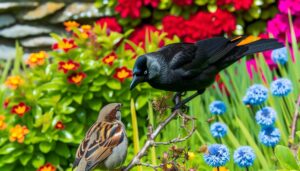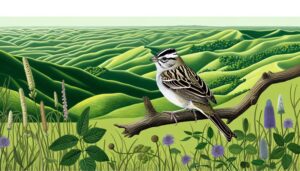7 Tips to Attract White-Throated Sparrows to Your Backyard
To attract White-Throated Sparrows, create a habitat featuring dense shrubs like juniper and evergreen trees for shelter. Use platform or ground feeders stocked with black oil sunflower seeds and millet, catering to their natural foraging habits.
Provide fresh water sources, especially during winter with heated birdbaths. Incorporate brush piles and nest boxes in sheltered areas to offer safe havens.
Make sure your garden mimics their preferred environment with varied vegetation and access to mixed woodlands. By maintaining these elements, you'll encourage these birds to visit regularly.
Understanding their seasonal needs can enhance your efforts.
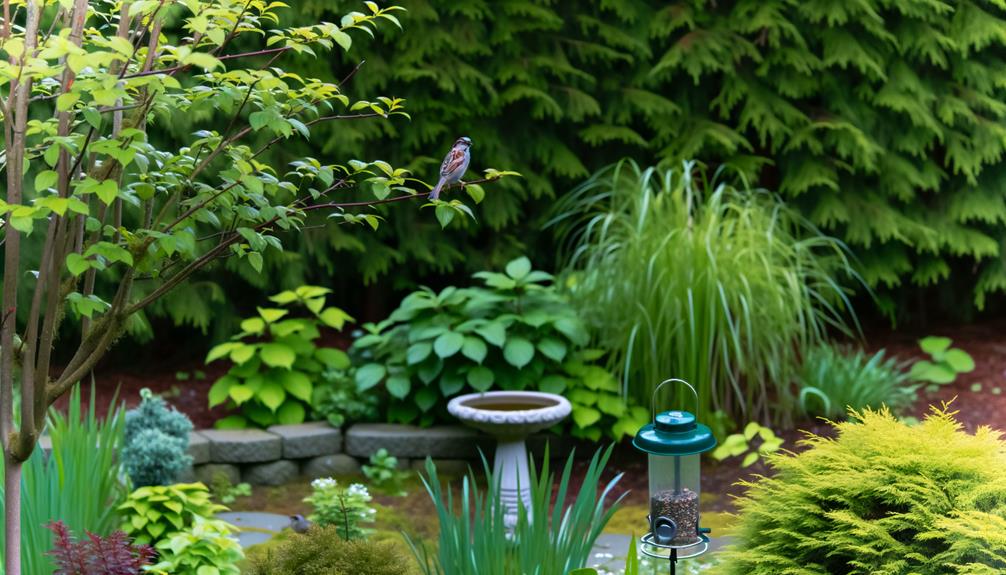
Key Takeaways
- Provide dense shrubs and evergreen trees for shelter and nesting.
- Use ground-level feeders with millet and black oil sunflower seeds.
- Ensure access to fresh, clean water year-round, especially in winter.
- Scatter brush piles and fallen branches for additional hiding spots.
- Incorporate mixed vegetation in your garden for diverse food sources and protection.
Recognize White Throated Sparrows
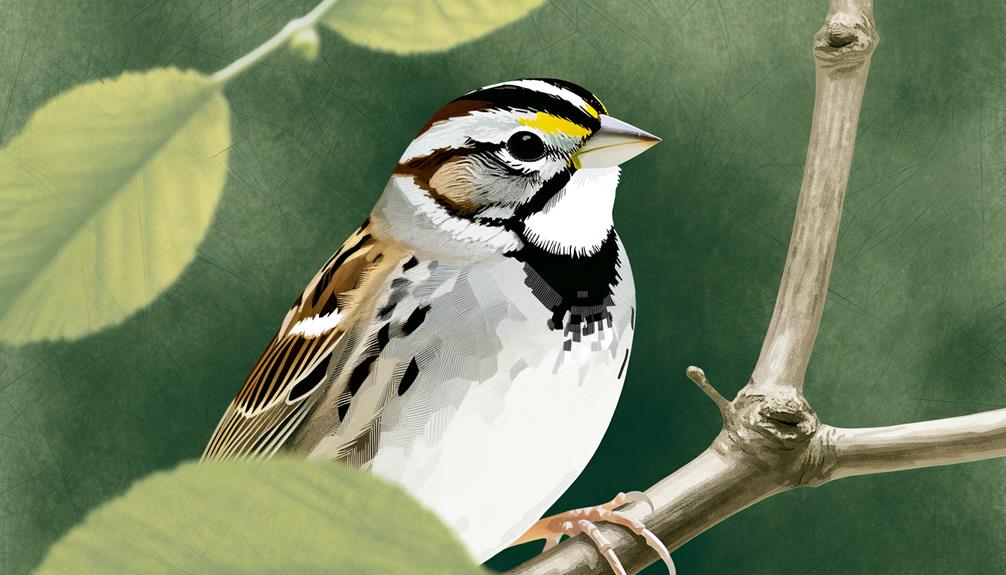
To accurately recognize White Throated Sparrows, one must observe their distinct physical characteristics, such as the bright white throat patch and the black-and-white striped crown. These birds typically exhibit a grayish-brown back and wings with two white wing bars.
The striking contrast between their yellow lores, located between the beak and eyes, and their dark eye-line further aids in identification. Juveniles may display a more subdued coloration but retain the characteristic throat patch. Their size averages around 6.75 inches in length, with a wingspan nearing 8.75 inches.
Behavioral traits include a distinctive, clear whistle song often described as “Oh-sweet-Canada.” Observing these markers allows bird enthusiasts to confidently identify White Throated Sparrows in their natural environments.
Ideal Habitat Requirements
White Throated Sparrows thrive in mixed woodlands, especially those that provide dense undergrowth and a mix of evergreen and deciduous trees. These environments offer the necessary cover and resources crucial for their survival and reproduction.
To create an optimal habitat for these sparrows, consider the following elements:
- Thick Undergrowth: Areas with thickets and shrubs provide protection from predators and ideal nesting spots.
- Varied Vegetation: A mix of evergreen and deciduous trees offers diverse food sources and shelter year-round.
- Forest Floor Debris: A ground layer abundant in leaf litter supports foraging for insects and seeds.
- Water Resources: Proximity to natural or artificial water bodies guarantees the birds have access to a steady water supply.
Understanding these needs helps in nurturing an environment where White Throated Sparrows can thrive.
Selecting the Right Food

Selecting the right food is essential for attracting White Throated Sparrows, as their seed preferences and seasonal food choices play significant roles in their foraging behavior.
These sparrows favor a diet rich in millet and sunflower seeds, with slight variations depending on the time of year.
Proper feeder placement enhances accessibility and visibility, ensuring these birds frequent your backyard regularly.
Seed Preferences
Many bird enthusiasts have discovered that the white-throated sparrow shows a marked preference for black oil sunflower seeds due to their high fat content and ease of consumption. This choice is scientifically sound, as these seeds provide essential energy, especially in colder climates.
To attract these sparrows effectively, there are a few critical considerations:
- Seed Type: Opt for black oil sunflower seeds, recognized for their thin shells and rich nutrient profile.
- Feeder Design: Use platform feeders or ground feeders to accommodate their foraging habits.
- Seed Freshness: Guarantee seeds are fresh to avoid mold and contamination, which can deter sparrows.
- Feeder Placement: Position feeders in quieter, sheltered locations to reduce stress and enhance feeding.
These steps help create an inviting environment for white-throated sparrows.
Seasonal Food Choices
Adapting to the changing seasons, white-throated sparrows adjust their dietary preferences to guarantee they receive peak nutrition year-round.
In spring and summer, they favor protein-rich insects such as caterpillars and beetles, essential for breeding and raising young.
As temperatures drop in autumn, they shift to high-energy seeds and berries, storing fat reserves for migration or winter survival.
Winter diets mainly consist of seeds—particularly millet and sunflower seeds—due to their caloric density and availability.
By understanding these seasonal shifts, bird enthusiasts can provide the best food sources at the right times, enhancing the sparrows' well-being and increasing the chances of attracting these birds.
Tailoring food choices to their natural preferences ensures they thrive in varied seasonal conditions.
Feeder Placement Tips
Effective feeder placement hinges on understanding the white-throated sparrow's natural foraging behaviors and habitat preferences. These birds often forage on the ground, so situating feeders at lower heights can mimic their natural environment.
Positioning feeders near dense shrubs or trees offers them security and a quick escape route from predators. Additionally, maintaining feeders clean and well-kept guarantees a healthy feeding environment.
To maximize success, consider these tips:
- Height: Place feeders near the ground.
- Cover: Position feeders close to dense vegetation for protection.
- Cleanliness: Regularly tidy feeders to prevent disease.
- Diversity: Provide a variety of seeds, such as black oil sunflower and millet.
These strategies align with the sparrow's instincts, fostering a safe and welcoming space.
Choosing Bird Feeders
Selecting the ideal bird feeder for attracting White Throated Sparrows involves considering factors such as feeder type, material, and placement to guarantee both accessibility and safety for these small songbirds.
Tube feeders with small perches are particularly effective, as they suit the sparrow's feeding habits. Constructed from durable materials like metal or UV-resistant plastic, these feeders withstand various weather conditions.
Ground feeders also appeal to White Throated Sparrows, mimicking their natural foraging behavior. Ensuring the feeder's placement in a sheltered, yet visible, location minimizes predation risk while offering an unobstructed view.
Incorporating baffles or squirrel guards enhances feeder security, further encouraging these sparrows to visit regularly. Thoughtful choices in bird feeder design create a hospitable environment for these charming avian visitors.
Providing Fresh Water
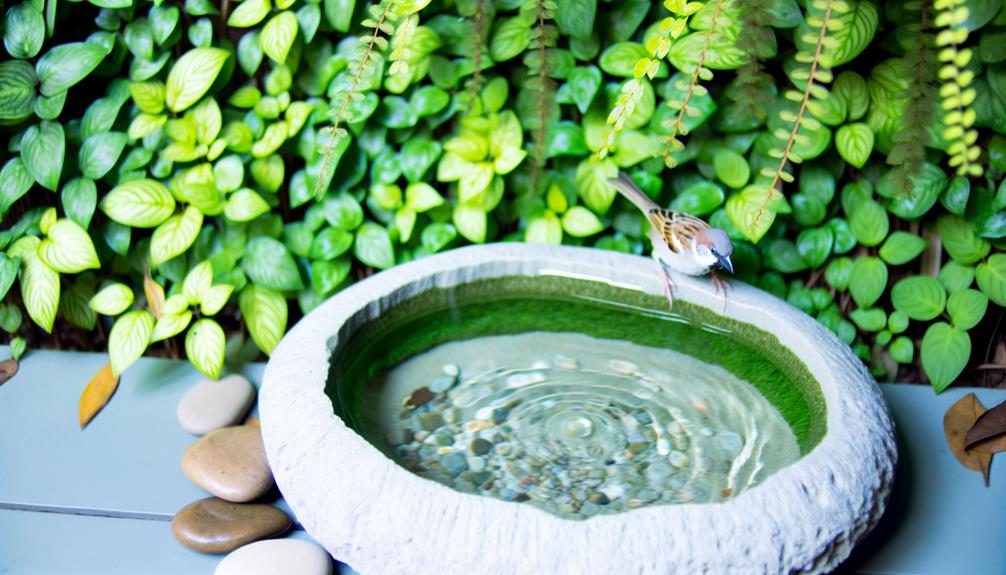
Access to fresh water is essential for attracting White Throated Sparrows, as it supports their hydration needs and encourages regular visits. Providing a consistent water source can be achieved by using bird baths or shallow dishes. To maximize effectiveness:
- Maintain Cleanliness: Regularly clean the water source to prevent algae and bacteria buildup.
- Ensure Freshness: Refill and refresh the water daily to keep it appealing and safe.
- Optimal Depth: Use shallow water, no more than 1-2 inches deep, to accommodate the birds' small size.
- Add Movement: Incorporate a dripper or small fountain to create gentle ripples, which attract sparrows more effectively than still water.
Planting Native Vegetation
To attract White Throated Sparrows effectively, one should prioritize planting native vegetation, which offers ideal food sources and habitat conditions.
Native plants not only meet the dietary needs of these sparrows but also provide essential shelter options.
Choose Native Plants
Incorporating native plants into your garden not only enhances the habitat for White Throated Sparrows but also supports the local ecosystem by providing essential food and shelter. Native plants are adapted to local soil and climate, making them resilient and less dependent on artificial fertilizers and pesticides.
They offer:
- Nutrient-rich berries: Plants like serviceberry and elderberry provide essential nutrients.
- Insect habitat: Native plants attract insects, a critical food source for sparrows.
- Seed sources: Grasses and wildflowers produce seeds that sparrows consume.
- Cover and nesting sites: Dense shrubs like dogwood and hazelnut offer protection.
Provide Shelter Options
Planting dense native vegetation like dogwood and hazelnut provides White Throated Sparrows with vital shelter and nesting sites, enhancing their chances of survival and reproduction. Dense thickets offer protection from predators and harsh weather, creating a microhabitat conducive to nesting and foraging.
Additionally, these plants support a rich insect population, an important food source for the sparrows. Native shrubs and trees promote ecological balance, fostering biodiversity.
It's important to take into account plant layering; ground cover, understory, and canopy layers mimic natural habitats, attracting not just sparrows but a variety of wildlife.
Offering Shelter Options
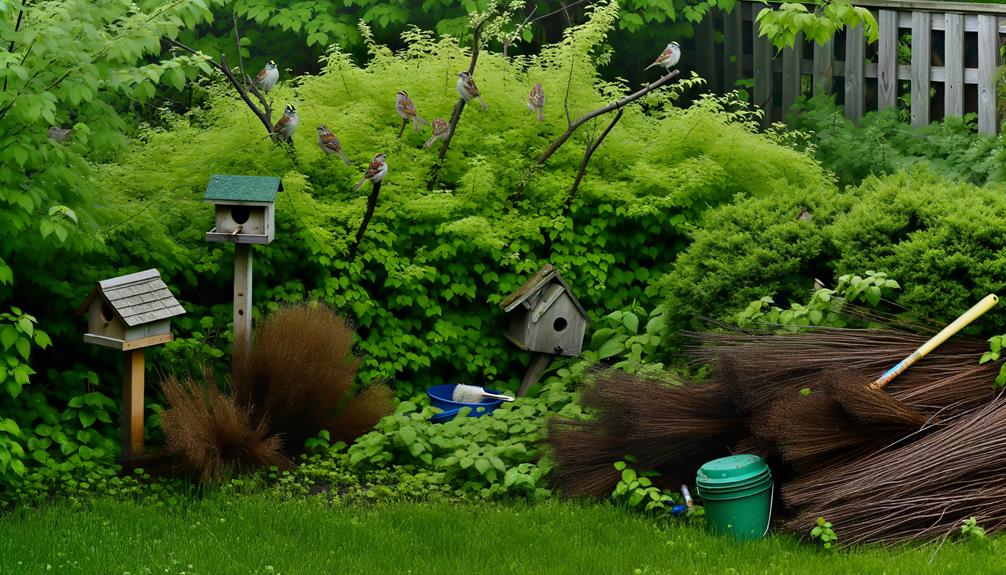
Providing adequate shelter for White Throated Sparrows involves strategically placing dense shrubs and evergreen trees to create safe havens from predators and harsh weather. These birds thrive in environments where they can find both immediate refuge and secure nesting sites.
To effectively attract these sparrows, one should consider the following:
- Plant Dense Shrubs: Use native shrubs like juniper or holly to provide low cover.
- Incorporate Evergreen Trees: Evergreens like pines offer year-round protection.
- Create Brush Piles: Arrange fallen branches and leaves to offer additional hiding spots.
- Install Nest Boxes: Place boxes in sheltered areas to encourage nesting.
Seasonal Care Tips
To guarantee the well-being of White Throated Sparrows year-round, one must adopt specific seasonal care strategies.
Winter feeding should prioritize high-energy foods, while appropriate nesting materials must be provided in the spring.
Maintaining a consistent water source is important, especially during freezing conditions and dry spells.
Winter Feeding Strategies
A strategic winter feeding regimen is crucial for attracting white-throated sparrows during the colder months, when natural food sources become scarce. By offering high-energy, nutrient-dense foods, one can guarantee these birds have the sustenance they need to survive harsh conditions.
Ornithologists recommend the following strategies:
- Provide Black Oil Sunflower Seeds: These seeds are high in fat and protein, aiding in energy retention.
- Install Suet Feeders: Suet cakes offer a concentrated source of calories that's essential for warmth.
- Scatter Millet on Ground: White-throated sparrows are ground feeders; spreading millet mimics their natural foraging behavior.
- Ensure Access to Fresh Water: Heated birdbaths prevent freezing, offering necessary hydration.
Implementing these methods will create a welcoming environment for white-throated sparrows throughout winter.
Nesting Material Choices
Selecting the finest nesting materials can greatly enhance the breeding success of white-throated sparrows, guaranteeing their nests are well-insulated and secure.
They prefer materials like grasses, twigs, pine needles, and moss for constructing their nests. To offer ideal choices, one could scatter these materials around the garden. Providing natural fibers, such as cotton or wool, can also be advantageous.
It's important to steer clear of synthetic materials, which can pose risks to the birds and their chicks. Monitoring the availability of these materials during spring and early summer ensures sparrows have uninterrupted access.
Water Source Maintenance
As temperatures fluctuate with the changing seasons, maintaining a clean and accessible water source becomes essential for the well-being of white-throated sparrows. Regular maintenance ensures that sparrows have a reliable hydration point, critical for their survival and health.
To keep water sources at their best, consider these steps:
- Regular Cleaning: Algae and debris can contaminate water. Clean bird baths at least once a week.
- Prevent Freezing: In colder months, use a heated bird bath or de-icer to prevent water from freezing.
- Shallow Depth: Make sure the water is shallow, around 1-2 inches, to accommodate small birds.
- Location Matters: Place water sources near shrubs or trees, providing cover from predators.
These practices maximize the water source's efficiency.
Monitoring and Maintenance
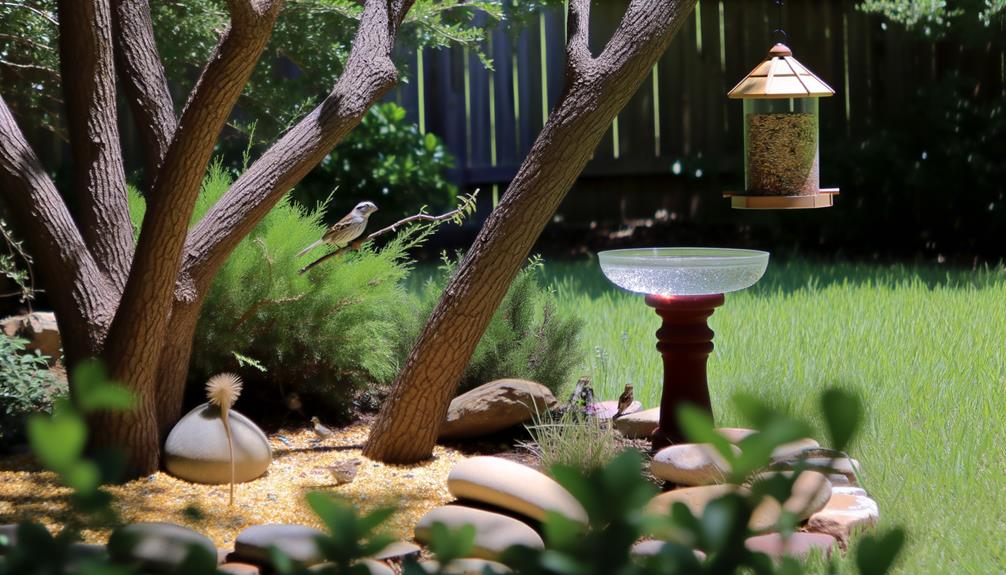
Consistently monitoring the white-throated sparrow's habitat guarantees that environmental conditions remain ideal for their sustenance and breeding. Regular checks on vegetation, water sources, and food supplies are vital. Monitoring involves observing bird activity, noting changes in behavior, and detecting potential threats.
| Aspect | Action Required |
|---|---|
| Vegetation | Trim overgrowth, maintain diverse plants |
| Water Sources | Clean frequently, prevent stagnation |
| Food Supplies | Replenish seeds, ensure variety |
In addition, maintaining bird feeders and nesting boxes is essential. Regular cleaning prevents disease, while replacing worn-out materials guarantees safety. By systematically inspecting these elements, one can address issues promptly, ensuring the habitat remains conducive to the sparrows' needs. This diligent approach fosters a thriving environment for the white-throated sparrow.
Enjoying Their Presence
By observing the white-throated sparrow's interactions and behaviors within their carefully maintained habitat, one can gain invaluable insights into their social structures and breeding habits. These observations can transform a casual birdwatcher into a dedicated ornithologist.
To maximize enjoyment, consider focusing on the following aspects:
- Foraging Behavior: Note how they search for food, as it reveals their dietary preferences and adaptability.
- Song Patterns: Listen for their distinct whistles, which play an essential role in territory establishment and mate attraction.
- Nesting Sites: Identify preferred nesting locations to understand their habitat requirements.
- Social Interactions: Observe flock dynamics and hierarchies, which can provide clues about their social organization.
Conclusion
By creating a welcoming environment tailored to the needs of White-Throated Sparrows, anyone can experience the joy of these charming birds.
Remember, 'if you create it, they'll come.' From providing ideal habitat conditions and nutritious food to offering fresh water and shelter, every detail counts.
Regular monitoring guarantees their well-being, making it possible to enjoy their presence year-round.
Through careful preparation and ongoing care, these delightful songbirds will thrive in your backyard oasis.



